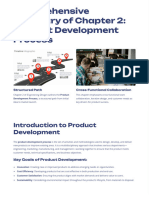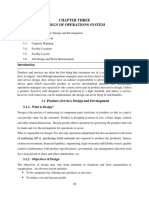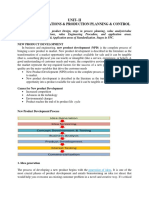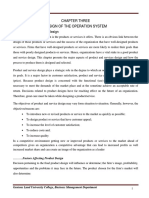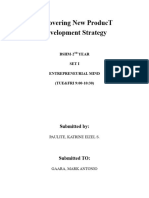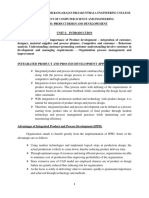Part 2 Product Design and Development
Uploaded by
ተክለወይኒ ገብረሚካኤልPart 2 Product Design and Development
Uploaded by
ተክለወይኒ ገብረሚካኤል1:
Chemical Engineering department
Production and project management
1. Product design and development
1.1. Introduction
Every organization has to design, develop and introduce new products as a survival and growth strategy. Organizations
objective of achieving growth of business is only through introduction of new products.
Organizations are required to design the new products for the following reasons;
• To be in business for a long time believing the fact that business is a long lasting institution
• To satisfy unfulfilled needs of the customer
• Company‟s existing product line becomes saturated and the sales are on the decline.
• To enter into new prospective businesses through diversification (related or unrelated
• Too much competition in the existing product line
• The profit margin is on the decline
Designing the physical manufacture of products involves three major phases or functions: marketing, design and product
development and manufacturing.
Set by: Tekleweyni G. MSc. in Material Science and Engineering
2:
1.2. Product life-cycle
The product once introduced into the market will undergo definite phases.
Figure 1 Product life-cycle
Product life cycle is an indication of time spans vary from few weeks or months (for novelty and fashion goods) to years.
Introduction stage: This stage marks the introduction of the product into the market. It may be an entirely new product in the market
or old product to the new market. The demand is low as customers do not know much about the product. So the organisations have to
invest heavily in advertisement to make the product familiar to the customer. The volume of sales will be low and if proper care is not
taken, the chances of product failures are high.
Growth: Once the product passes through the introduction stage, the sales starts increasing because of the acceptability of the
product by the customer. The sales growth rate is high because of limited or no competition.
Maturity (Saturation): The sales growth reaches a point above which it will not grow. This is due to the market share taken by the
competitor‟s products. Thus, the sales will be maintained for some period.
Decline: The competitors will enter the market with better product features, advanced technology and reduced prices. This is a threat
to the very existence of product and sales start declining. If proper care likes addition of special features, design changes are not
incorporated there comes a time when the products are to be taken back from the market.
1.3. Product design/development process
Product design deals with conversion of ideas into reality. Every business organization has to design, develop and introduce new
products as a survival and growth strategy. Developing the new products and launching them in the market is the biggest challenge
faced by the organizations.
Product development translates the needs of customers given by marketing into technical specifications and designing the various
features into the product to these specifications. Manufacturing has the responsibility of selecting the processes by which the product
Set by: Tekleweyni G. MSc. in Material Science and Engineering
3:
can be manufactured. Product design and development provides link between marketing, customer needs and expectations and the
activities required to manufacture the product.
It has five basic stages:
Stage I: Conception
The draft specifications for the product are laid down incorporating the user requirements at this stage. This stage provides the basis
for all subsequent design activities. The specifications of the proposed product must be prepared by marketing department in as much
details as possible. Eg: quantity, appearance, performance, processing cost, and date of introduction.
Stage II: Acceptance
This is a stage where the design activity of the product begins after the feasibility analysis and model making and calculations of the
product is accepted.
Stage III: Execution
The cost of the product is built at this stage which the production engineers always try to stick to it. Now the advanced techniques like
rapid prototyping technique (RPT) and experimental stress analysis techniques are available for prototype, modeling and testing.
Stage IV: Translation
At this stage the production engineering department is involved in design work. The manufacturing feasibility is tested at this stage.
The final manufacturing drawings are prepared1.
Stage V: Pre-production
In large scale production, it is recommended to carry out a pilot run under production conditions. This will consist of completely
assembling quantity of production from parts or components made by normal production method and using the same degree of skill in
the operatives which will be found in the final manufacture. The pre-production run will ensure the quality, reliability of product as per
the specifications before the production will be started on commercial basis. Thus the pre-production stage will check:
1. Drawings
2. Final tools.
3. Production techniques and estimates.
4. Specifications.
Set by: Tekleweyni G. MSc. in Material Science and Engineering
4:
1.4. Factors affect/ consideration new product design
Marketing Aspects
Once the product is selected, then it is very important to know the marketability of the product relates with acceptability to the
product. If there is no potential market, then it is a wasteful exercise to design and manufacture the product.
Functional Aspects
The functional scope of the product is to be carefully analyzed and the functions are to be defined properly. It includes what function
expected to perform and easily runnable.
Durability and Dependability
These two factors define the quality and reliability of the product. Durability refers to the length of the active life of the product under
given working conditions. Dependability refers to the reliability with which the product serves its intended function. Thus, quality of the
product is directly proportional to the quality of inputs (materials, men, etc.), the process of manufacture. Reliability is a measure of
the ability of a product, a part, a service, or an entire system to perform its intended function under a prescribed set of conditions.
Aesthetic Aspect
Aesthetic aspect refers to the “external look good‟ aspect of the product and it is concerned with molding the final shape around the
basic skeleton. Aesthetic aspects help the selling function of the product by attracting the customers and creating the first impression
about the product. For consumer goods aesthetics is the dominant factor in creating the demand for the product. Styling becomes the
important factor in product design in situations such as changes in fashion and taste, evolution of form and introduction of new ideas
to quickly outdate the old ones.
Economic Analysis
An economic analysis is the key to the management decision in product design policy. It deals with investment needed, expected profit,
and volume expected to produce.
1.5. Standardization
Standardization is a tool for variety reduction–“Standardization is a process of defining and applying the conditions necessary to
ensure that given range of requirements can normally be met with a minimum of variety and in a reproducible and economic manner
on the basis of the best current techniques.”
Set by: Tekleweyni G. MSc. in Material Science and Engineering
5:
Objectives of Standardization
1. Interchangeability of parts, components, etc.
2. Keeping the variety minimum.
3. Helps to achieve a better control due to reduced variety.
1.6. Quality control
Quality Control (QC) may be defined as „a system that is used to maintain a desired level of quality in a product or service‟. It is a
systematic control of various factors that affect the quality of the product. Quality control aims at prevention of defects at the source,
relies on effective feedback system and corrective action procedure. Quality control can also be defined as „that industrial
management technique by means of which product of uniform acceptable quality is manufactured‟. It is the entire collection of
activities which ensures that the operation will produce the optimum quality products at minimum cost.
Reference
1. TELSANG MT. Industrial Engineering And Production Management.; 2015.
2. Kumar SA, Suresh N. Production and Operations Management. 2nd ed.; 2008.
Set by: Tekleweyni G. MSc. in Material Science and Engineering
You might also like
- 100K-Report Katrina Ruth 0 To 100K Per Month Blueprint100% (2)100K-Report Katrina Ruth 0 To 100K Per Month Blueprint36 pages
- Comprehensive Summary of Chapter 2 Product Development ProcessNo ratings yetComprehensive Summary of Chapter 2 Product Development Process13 pages
- product development(Unit 2 continuation Part) (1)No ratings yetproduct development(Unit 2 continuation Part) (1)10 pages
- Unit 3 - Design of The Operation System Part One.No ratings yetUnit 3 - Design of The Operation System Part One.32 pages
- Q:-Discuss The Stages in Product Design Process: 1. Idea GenerationNo ratings yetQ:-Discuss The Stages in Product Design Process: 1. Idea Generation7 pages
- Chapter Two Design of The Operations/production Systems 2.1. Product-Service Design and DevelopmentNo ratings yetChapter Two Design of The Operations/production Systems 2.1. Product-Service Design and Development42 pages
- Discovering New Product Development StrategyNo ratings yetDiscovering New Product Development Strategy7 pages
- Manufacture Product Design and Process SelectionNo ratings yetManufacture Product Design and Process Selection23 pages
- QB 16 Mark - Industrial Design & DevelopmentNo ratings yetQB 16 Mark - Industrial Design & Development29 pages
- Opertion Management Module 3 Product and Service Design 23 24 SSNo ratings yetOpertion Management Module 3 Product and Service Design 23 24 SS7 pages
- New Product Development Essentials: Hands-on Help for Small Manufacturers and Smart Technical People: No Nonsence Manuals, #2From EverandNew Product Development Essentials: Hands-on Help for Small Manufacturers and Smart Technical People: No Nonsence Manuals, #24/5 (1)
- # Direct and Indirect Channel Strategy Competitive ReviewNo ratings yet# Direct and Indirect Channel Strategy Competitive Review7 pages
- UUMW.S4048 - Speakers and Amplifiers Fo..No ratings yetUUMW.S4048 - Speakers and Amplifiers Fo..3 pages
- Business and Management Non Graduating CMU RegistrarNo ratings yetBusiness and Management Non Graduating CMU Registrar11 pages
- Traction - A Startup Guide To Ge - Justin Mares - Part3No ratings yetTraction - A Startup Guide To Ge - Justin Mares - Part310 pages
- The Impact of Personal Selling On The Purchasing Behavior Towards-With-Cover-Page-V2No ratings yetThe Impact of Personal Selling On The Purchasing Behavior Towards-With-Cover-Page-V29 pages
- Go Global With Multi-Language Audio - Multi-Pager - enNo ratings yetGo Global With Multi-Language Audio - Multi-Pager - en5 pages
- 51 ChatGPT Secret Prompts For Creating An Online BusinessNo ratings yet51 ChatGPT Secret Prompts For Creating An Online Business21 pages
- Brown Playful Scrapbook Digital Marketing PresentationNo ratings yetBrown Playful Scrapbook Digital Marketing Presentation10 pages
- karaage fried chicken franchice business plan draftNo ratings yetkaraage fried chicken franchice business plan draft4 pages
- Tourism and Hospitality Customer RelationsNo ratings yetTourism and Hospitality Customer Relations25 pages
- A Study of Marketing Strategy and Consumer Behaviour Hygreens HydroponicNo ratings yetA Study of Marketing Strategy and Consumer Behaviour Hygreens Hydroponic5 pages
- Fredco vs. President and Fellows of Harvard College (Harvard University)No ratings yetFredco vs. President and Fellows of Harvard College (Harvard University)1 page
- Startup Costs and ROI For Cocktail BombsNo ratings yetStartup Costs and ROI For Cocktail Bombs2 pages
- Retail Chap 7 - CUSTOMER RELATIONSHIP MANAGEMENT PROCESSNo ratings yetRetail Chap 7 - CUSTOMER RELATIONSHIP MANAGEMENT PROCESS18 pages
- 100K-Report Katrina Ruth 0 To 100K Per Month Blueprint100K-Report Katrina Ruth 0 To 100K Per Month Blueprint
- Comprehensive Summary of Chapter 2 Product Development ProcessComprehensive Summary of Chapter 2 Product Development Process
- Q:-Discuss The Stages in Product Design Process: 1. Idea GenerationQ:-Discuss The Stages in Product Design Process: 1. Idea Generation
- Chapter Two Design of The Operations/production Systems 2.1. Product-Service Design and DevelopmentChapter Two Design of The Operations/production Systems 2.1. Product-Service Design and Development
- Opertion Management Module 3 Product and Service Design 23 24 SSOpertion Management Module 3 Product and Service Design 23 24 SS
- New Product Development Essentials: Hands-on Help for Small Manufacturers and Smart Technical People: No Nonsence Manuals, #2From EverandNew Product Development Essentials: Hands-on Help for Small Manufacturers and Smart Technical People: No Nonsence Manuals, #2
- # Direct and Indirect Channel Strategy Competitive Review# Direct and Indirect Channel Strategy Competitive Review
- Business and Management Non Graduating CMU RegistrarBusiness and Management Non Graduating CMU Registrar
- Traction - A Startup Guide To Ge - Justin Mares - Part3Traction - A Startup Guide To Ge - Justin Mares - Part3
- The Impact of Personal Selling On The Purchasing Behavior Towards-With-Cover-Page-V2The Impact of Personal Selling On The Purchasing Behavior Towards-With-Cover-Page-V2
- Go Global With Multi-Language Audio - Multi-Pager - enGo Global With Multi-Language Audio - Multi-Pager - en
- 51 ChatGPT Secret Prompts For Creating An Online Business51 ChatGPT Secret Prompts For Creating An Online Business
- Brown Playful Scrapbook Digital Marketing PresentationBrown Playful Scrapbook Digital Marketing Presentation
- karaage fried chicken franchice business plan draftkaraage fried chicken franchice business plan draft
- A Study of Marketing Strategy and Consumer Behaviour Hygreens HydroponicA Study of Marketing Strategy and Consumer Behaviour Hygreens Hydroponic
- Fredco vs. President and Fellows of Harvard College (Harvard University)Fredco vs. President and Fellows of Harvard College (Harvard University)
- Retail Chap 7 - CUSTOMER RELATIONSHIP MANAGEMENT PROCESSRetail Chap 7 - CUSTOMER RELATIONSHIP MANAGEMENT PROCESS


